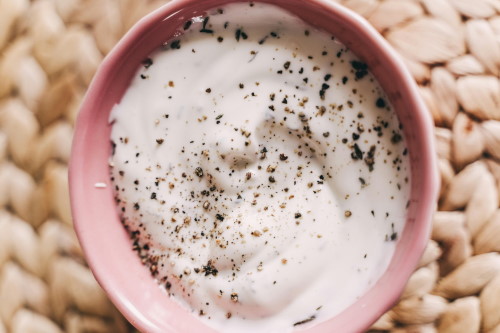The new qualified claim states that "Eating yogurt regularly, at least 2 cups (3 servings) per week, may reduce the risk of type 2 diabetes, according to limited scientific evidence."
BREAKING: Diabetes Breakthrough Leaves Doctors Speechless - Try This Tonight
How Could Yogurt Potentially Impact Type 2 Diabetes Risk?
According to the FDA statement, the agency concluded there “is some credible evidence” of benefit from eating yogurt as a whole food, but not because of any particular nutrient or ingredient contained in it.
Yogurts that contain probiotics may have anti-inflammatory properties to help combat elevated blood sugars (hyperglycemia), an inflammatory response that can cause damage to blood vessels, says Beth Czerwony, RD, at Cleveland Clinic’s Digestive Disease and Surgery Institute in Ohio.
Right now, the evidence on whether yogurt could reduce the risk of type 2 diabetes is limited and additional research is needed to confirm that hypothesis, says Czerwony.
“It is too difficult to support a claim that a single food could help prevent type 2 diabetes on its own. Certainly, if yogurt is being used as part of a healthy and balanced diet, there may be some correlation between cause and effect, but again, research is limited,” she says.
A ‘Qualified’ Health Statement Means the Evidence Isn’t Strong
Even Danone recognized that there isn’t enough evidence to claim that yogurt can help prevent type 2 diabetes — that’s why the company requested a qualified claim backed by only “limited evidence,” says Bonnie F. Liebman, director of nutrition at the Center for Science in the Public Interest, a food and health advocacy group based in Washington, D.C.
A qualified health claim doesn’t have to meet the more rigorous “significant scientific agreement” standard required for an authorized health claim, per the FDA statement.
The company’s evidence is limited because it comes from observational studies that cannot prove cause-and-effect, Liebman says. “Those studies may find that yogurt eaters have a lower risk of diabetes, but something else about yogurt eaters could explain their lower risk. They may eat a healthier diet, exercise more, or get more regular checkups, for example,” says Liebman.
“Danone failed to cite stronger evidence from randomized controlled trials showing that yogurt can reduce the risk of type 2 diabetes or even markers of diabetes risk, like lower blood sugar levels,” she says.
The New Claim Covers All Types of Yogurts — Even Those Loaded With Sugar
The new qualified health claim applies to all yogurt that meets the FDA’s “standards of identity,” a term that refers to the requirements around the content and product of certain foods. In this case, what amount of live and active yogurt cultures need to be present? How much sugar and other ingredients can be added and still be called yogurt?
The rule is the same for all yogurt — even those with added sugars — because much of the existing research on yogurt and type 2 diabetes doesn’t distinguish between yogurts of varying sugar or fat content when showing a potential benefit, suggesting yogurt of any type could have a protective effect, says Amanda Blechman, RD, director of Health and Scientific Affairs at Danone North America.
Will the Claim Empower People or Confuse Them?
“Our hope is that this announcement will empower consumers with simple, actionable information they can use to help lower their risk of developing type 2 diabetes through a realistic, easy-to-make dietary modification,” said Miguel Freitas, PhD, vice president of Health and Scientific Affairs at Danone North America, in the statement.
But because the new claim can be placed on all yogurts, even those “loaded” with sugar, Liebman believes the new claim is more likely to confuse consumers.
“Danone’s YoCrunch line, for example, comes with Oreos, M&Ms, Twix, or Snickers you can mix in. One YoCrunch with Oreo Cookie Pieces has a third of a day’s added sugar,” she points out. In an 8-ounce serving, there are 24 grams of total sugars, which includes 18 grams of added sugar — and adds up to 36 percent of the recommended amount of sugar intake for the day.
“Even an ordinary Dannon strawberry yogurt has a quarter of a day’s added sugar,” says Liebman.
The FDA’s own studies show that consumers don’t distinguish between health claims based on strong evidence versus claims that cite limited evidence, she points out. “What’s more, companies can slap a large ‘may prevent diabetes’ claim on the front of a yogurt package with an asterisk that cites ‘limited evidence’ in tiny print on the back,” says Liebman.
How to Decide Which Yogurt Is Right for You
TRENDING: This Keeps Your Blood Sugar Below 100 - Even When You're Eating Sweets!
Czerwony agrees that all yogurts aren’t created equal, and that consumers may need to educate themselves on how to interpret the food label to find out if a particular yogurt will support their health goals. “Knowing what ‘budget’ you have for categories such as added sugar, total carbohydrates, or protein will allow you to make a better decision on what brand to purchase,” she says.
Czerwony offers a few tips to help you pick the right yogurt according to your needs.
- Add your own fresh fruit. If you’re looking for a healthy, low-fat snack, a low-fat or fat-free plain yogurt with added fresh fruit may be the best option.
- Pick Greek yogurt if you want more protein. For someone who has higher protein needs, such as someone actively looking for weight loss or had recent surgery, Greek yogurt may be a better choice.
- New to yogurt? Try blending. For people who aren’t familiar with yogurt, try blending both low-fat and Greek yogurt to help you get used to the consistency and tang.
- Look for live cultures. Find a yogurt that has live cultures, which can help with healthy gut microbiome.








